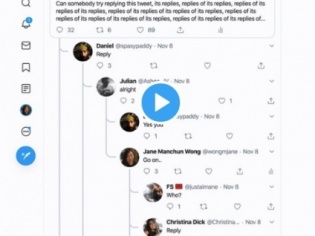-
Team TechTree
08:09 29th Nov, 2019
Twitter Experiments with Conversation Displays | TechTree.com
Twitter Experiments with Conversation Displays
The social media platform has been seeking ways to enhance engagement through a variety of user experience tests though some of its ideas appear to be dated

What does one do if one’s business model revolves around 140 characters? For starters, double it to 280 and wait for things to happen! Well, Twitter did so just over two years ago and users were a happy lot as could use more words to rant. However, nothing much changed in the way the social media platform engaged with its customers.
Maybe that’s the reason the Jack Dorsey-led company launched a prototype version of itself earlier in March having initially come out with a version in January. The prototype build called Twttr represented a space outside the public network and was meant to experiment with new ideas about how Twitter should look, feel and operate.
Over the past few months, it has done just that, especially in the area replies to tweets and how users consume long conversation threads on the platform. By the looks of it, the company is using the platform extensively though some of their ideas appear to be dated, as is the one that was reported by reverse engineer Jane Manchun via her tweet.
The latest experiment seems to be a straight lift from how Reddit structured its conversation tree or one could even hark back to the internet stone age phenomenon of the conversation tree where users could keep clicking and going deeper into the content. There used to be a time when websites created such trees for their user comments section – an area that is losing significance by the day now.
So, what exactly is happening with the Twttr experiment? Media reports suggest that it could be a result of key personnel being moved from roles within the company. A few months ago, Sara Haider who was in charge of conversations design had announced that she was moving to a new role. She was replaced by Suzanne Xie, who seems to be just getting into the mood, given the recent activity.
By the looks of it, the effort behind the UI/UX activity appears to revolve around the ability to focus on a specific tweet with users having the flexibility to go as deep as they choose to without hampering their experience in any fashion. In other words, you tap a thread that you seek to delve deeper without having to take the trouble of sifting out what doesn’t interest you.
Not a bad thought, given that at present the original tweet is represented by a small microphone and Twitter now draws a thin line to connect it with the various responses that are listed below. However, the challenge is that users end up going through loads of junk, including profanities before resting on the truly invigorating parts.
Of course, just so that we don’t go overboard with these new features, Twitter is upfront in informing us that experiments found on Twttr needn’t all be incorporated on to the platform.
Earlier this year, there were several experiments around ways to make liking tweets an easier option, with the tests ironically coinciding with the comments from Jack Dorsey on whether the button could be even removed altogether, given that it was incentivizing bad behavior on the social network. Of course, the experiments haven’t yet seen the light of the day!
Earlier this month, Twitter had made available the “Hide Replies” features to users whereby the original poster gets to control which replies to a tweet remain visible. It is being considered the biggest tweak to the social platform since the ability to Retweet was offered many moons ago. While replies aren’t actually deleted, they’re placed behind an extra click now which means trolls are finding it tougher to piggyback on influencers.
And with the latest experiments with how the thread actually shows up, the tree formation could well be the solution to shut them up completely, unless of course other trolls want to continue the conversation. Of course, it wouldn’t really matter as even if they do so, the sane ones can just ignore that section of the conversation tree!
TAGS: Twitter, Conversations, UI/UX, Reddit
- DRIFE Begins Operations in Namma Bengaluru
- Sevenaire launches ‘NEPTUNE’ – 24W Portable Speaker with RGB LED Lights
- Inbase launches ‘Urban Q1 Pro’ TWS Earbuds with Smart Touch control in India
- Airtel announces Rs 6000 cashback on purchase of smartphones from leading brands
- 78% of Indians are saving to spend during the festive season and 72% will splurge on gadgets & electronics
- 5 Tips For Buying A TV This Festive Season
- Facebook launches its largest creator education program in India
- 5 educational tech toys for young and aspiring engineers
- Mid-range smartphones emerge as customer favourites this festive season, reveals Amazon survey
- COLORFUL Launches Onebot M24A1 AIO PC for Professionals







TECHTREE